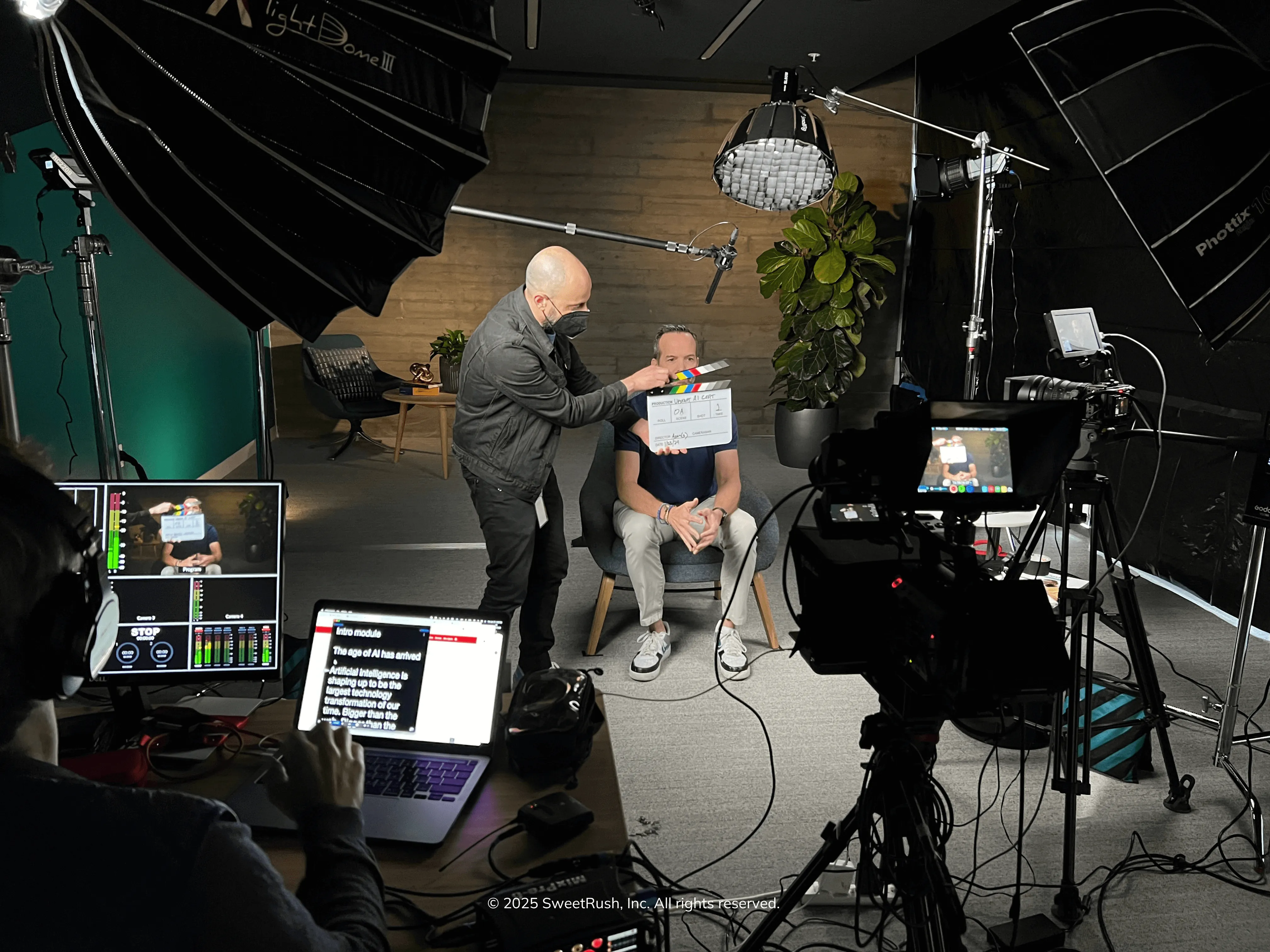.webp)
From pre-production to continuity, a film set is a model of efficiency. Read on for 5 lessons of learning video production you can apply to every L&D project.
It's 7 a.m. in Los Angeles, California—the birthplace of cinema. The film set is already buzzing with energy. The core team is in position, ready to roll according to the strict plan laid out by the producer: Lights are set, the stage is clean, and the actors are prepped.
I'm here supervising post-production elements for the XR team and, as I watch the production staff fine-tune the last details, I pause for a moment.
It's truly impressive to see this group of people operate like a perfectly synchronized machine, where every piece helps the next one move without friction. I can’t help but wonder, How can we get our everyday teams to achieve this same level of precision and harmony?
In the video world, functioning this way is crucial: Time is money, and a lost minute means an immediate financial hit. But this principle applies to any area of production. The difference is that when the consequences aren't as visible or the results aren't as immediate, we sometimes overlook this essential detail.
After the pandemic, organizations showed a significant rise in interest when it came to incorporating video into their learning projects. I’ve had the pleasure of participating actively in these productions—first as an observer, then taking on roles where I could directly apply my expertise and knowledge.
Though our custom learning video shoots may not create Hollywood blockbusters, they follow the same proven processes that ensure the success of any team. Read on for the 5 fundamental lessons I’ve learned from my time behind the clapperboard…and have brought into my daily routine.
.png)
On a set, time is the most expensive resource. A minute wasted due to a dead battery or the wrong lens can cost a project thousands of dollars. But thanks to the Pre-Production phase, these setbacks rarely happen.
I’ve learned the hard way that pre-production saves pain. As one of my professors used to say, "Measure twice, cut once." On set: few things are more disappointing than reviewing the playback only to realize the footage isn’t usable or the beautiful design the crew spent all day setting up completely misses the mark. These kinds of mistakes aren’t just financially costly; they also hurt morale.
%20copy-min%202.webp)
Q: Who is more important on a film set: the director, cinematographer, electrician, or grip?
A: All of the above.
If the grip can't safely position a light, the cinematographer can't get the shot, the director won't have the scene. There’s a chain of command, but everyone on the org chart is equally valuable.
Before dismissing any task as minor or trivial, consider this old saying: “For want of a nail, the horseshoe was lost. For want of a horseshoe, the steed was lost. For want of a steed, the message was not delivered. For want of an undelivered message, the war was lost.”

On a film set, the call sheet isn't a suggestion; it's a contract. It dictates when each person must be in makeup, on set, and, most importantly, the exact time each scene must be shot. Respect for these times is absolute, because a delay affects dozens of people and thousands of dollars.
Task Blocking: Apply the call sheet mindset to your individual tasks. Block time for specific tasks (e.g., 9:00 to 10:30 AM, "Project X Outline Creation"). When time is up, firmly tell yourself to "Cut!"
%20copy-min.webp)
Immediately after a key take, the director and cinematographer review the playback on a high-quality monitor. If there's a wardrobe issue, a lighting problem, or a missed line, it’s fixed then and there, while the crew and resources are ready. There’s no waiting until the next day or until editing.
One team that knows the value of playback is our XR team. When I film with them, we don't wait to see the final product; instead, we integrate immediate playback from the people involved in the project at different production stages. By testing prototypes several times and giving instant feedback, we ensure the experience is polished and effective long before the finish line.
-min.webp)
If you’ve ever seen a character wearing a red shirt in one shot and, five seconds later, a blue one, you’ve spotted a continuity error. Continuity ensures that details, props, and light remain identical among takes that may have been filmed weeks apart…and it requires the entire crew to be aligned.
Absolute continuity demonstrates respect for the client, their brand guidelines, as well as the tone and quality of our daily communications with them. That consistency builds trust and shows them that we value the relationship.
%20copy%202-min.webp)
All of this discipline, technique, and commitment—from the detailed prep (Lesson 1) to the timely feedback (Lesson 4)—come into service for one reason: delivering a perfect vision.
A film set is like a factory: It’s a model of efficiency under pressure, in which discipline, communication, and respect for the process are absolute must-haves. Applying these mindsets and best practices of learning video production into our daily work makes us more productive professionals and ensures that our "final product" is coherent, well-executed, and delivered on time
If you’ve got a training initiative that requires high-quality learning videos and animation, we’d love to show you how we bring these best practices to life. Reach out to share your vision for turning these lessons into "Action!"
-min%20(1).webp)
José Redondo is a Creative Director with over 25 years of experience in the production and design field. Over his 17-year tenure at SweetRush, he has shaped countless projects by leveraging his diverse skillset in a variety of roles. Jose has served as Creative Director, Animator, Illustrator, Designer, and Editor—and most importantly, as a leader of multidisciplinary teams. He currently leads the XR Design and Visual Team.